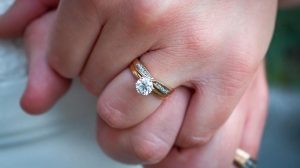As Wedding Know How editors, we write about things that we love and we think you'll like too. We have affiliate partnerships and sponsorship and may generate some revenue from these at no cost to you.
One of the three birthstones of June, alexandrite is a beautiful and rare gemstone. In fact, it’s rarer than diamonds and one of the most expensive gems in the world. It has a lovely color and chameleon-like qualities, making it excellent for jewelry. Few gemstones are as fascinating as alexandrite, so here are the 10 things you should know before you shop.
What is alexandrite?

Alexandrite ring by K Best Design. See it here.
Alexandrite is a rare variety of chrysoberyl and is well known for its remarkable color change in different light conditions. In fact, gem aficionados often describe alexandrite as emerald by day, ruby by night because it has a bluish green color in daylight or fluorescent light, and a purplish red color in incandescent light or candlelight.
However, not all color-changing chrysoberyls are alexandrites. The difference between the two is that alexandrite has impurities of iron, chromium and titanium. Technically, alexandrite requires chromium and beryllium together, but the two elements rarely occur in the same rock. This makes the color change in an alexandrite gemstone very dramatic and obvious.
Russia is the most famous alexandrite source, but the stone can also be mined in Brazil, Sri Lanka, Zimbabwe, Madagascar, Myanmar and some East African countries.
What causes alexandrite’s color changing property?
The color change in the gemstone is caused by chromium, which is the same element that causes ruby’s red, and emerald’s green. However, there’s something special how alexandrite interacts with light, making it display both red and green colors.
In science, white light contains all the colors of the rainbow, and a particular gemstone absorbs and reflects different wavelengths of light. When the light is not absorbed, it’s reflected and perceived as the color of the gemstone. When there is chromium ions in the stone, it allows it to absorb some colors of light while and reflect others.
During the day, a greater proportion of green light is reflected so we see green in alexandrite. At night, there’s a greater amount of red light in candle light and incandescent light, which chromium ions don’t absorb, leading to the purple red color of alexandrite.
What are alexandrite quality factors?
Like most gemstones, alexandrite is evaluated using the classic 4 Cs: color, clarity, cut and carat. Just keep in mind that the strength of its color change is the most important quality factor. Since the gemstone displays two different colors, determining its value is more complex.
Alexandrite Color and Color Change

Alexandrite studs by Jet Flair. See them here.
For alexandrite, it’s not just the tone, hue and saturation that affect its value, but also its ability to change color. Alexandrite can have color change that ranges from 100% to just 10%. The more distinct its color change, the higher the value.
More than that, the color change in the gemstone should have a high saturation in both its green and red colors.
- Russian alexandrites have vivid bluish green and purplish red colors, which remain the standard color for the gemstone.
- Even if Sri Lankan alexandrites are generally larger than Russian varieties, they tend to lack in intensity and are yellowish and brownish, making them less desirable.
- Brazilian alexandrite tends to have pale colors.
- Zimbabwean alexandrite is valued for their emerald-green color in sunlight.
When it comes to alexandrite’s tone, it shouldn’t be too dark to the point it appears almost black, or too light that it doesn’t reach the quality of pure green and red colors.
Alexandrite Clarity
A high clarity rating makes an alexandrite valuable, providing it has a great color change and saturation. In GIA clarity grading system, alexandrite is regarded as type 2 stone, which means that it’s usually included. It only means that the best alexandrite is still expected to have few inclusions.
Sometimes, the gemstone can show chatoyancy due to its needle-like inclusions, but it’s rare and more valuable. The cat’s eye effect appears when a white line shines on the center of a cabochon-cut alexandrite stone, as it moves under a light source.
Alexandrite Cut
Cut is one of the most important factors in a gemstone’s appearance. It’s the cut that allows the gemstone to show the strongest color change through the crown. Because of alexandrite’s rarity, it’s often cut for maximum weight retention. Most of the time, it’s found in mixed cuts, featuring step-cut pavilions and brilliant-cut crowns. Oval and cushion cuts are also popular.
Alexandrite Carat Weight
Alexandrite used in jewelry is usually under one carat. Gemstones over five carats are extremely rare. Size always affects its value, as larger sizes and higher-quality alexandrite rises in price dramatically.
How much does alexandrite cost?
Because of its rarity and limited deposits in the world, alexandrite is more expensive than ruby, emerald, sapphire, and sometimes diamonds. A high quality alexandrite can cost up to $15,000 per carat. However, an alexandrite with a dramatic color change and vivid hues might range from $50,000 to $70,000 per carat!
Keep in mind that its distinct color change makes it more expensive and valuable. If you’re on a budget, you may think of purchasing a larger alexandrite with less color change. If you’re after the magical alexandrite effect, you may still compromise size for color change.
Gemstones that are lacking in brightness, as well as those with lower color intensities are cheaper in price. Be careful when buying an alexandrite at a relatively bargain price, as it could likely not be an alexandrite. Always look for gemological credentials and an independent laboratory report.
What’s a “created” alexandrite?
This refers to a synthetic alexandrite—but it’s not a fake stone. The Federal Trade Commission Jewelry Guides allow the terms laboratory-created or laboratory-grown to describe synthetic gemstones. An artificially grown alexandrite has the same crystal structure and chemical makeup as the natural stone, making it real and valuable.
Manufacturers grow synthetic alexandrite though flux, melt and hydrothermal methods. Since these are costly processes, they remain one of the most expensive lab-created stones. To know whether an alexandrite is natural or not, gemologists identify the stone through inclusions caused by various methods and procedures. Some of these synthetic stones will show some bubbles and liquid inclusions, as well as inclusions of platinum from the flux method.
Is alexandrite a durable stone for jewelry?
In the Mohs scale of hardness, alexandrite ranks 8.5, which makes it a great choice for any jewelry piece. In fact, it’s next to rubies and sapphires which have a hardness of 9. Also, as alexandrite has no cleavage, it doesn’t have the tendency to split when struck with a hard blow.
From earrings to necklaces, bracelets and rings, alexandrite is suited for everyday wear. While it’s difficult to compare with diamonds, its rarity and long-lasting nature make it a perfect option for engagement ring or any heirloom jewelry piece.
What are the alexandrite imitations to watch out for?
Alexandrite imitations are called simulants, mimicking the appearance of the stone. But they’re not the same as lab-created alexandrite. They’re just look-alikes, but they don’t have the same crystal structure and chemical makeup of a natural stone.
- Simulants made of plastic and glass can be easier to spot, but some are made of corundum (sapphire) or garnet.
- When it comes to a simulated alexandrite made of sapphire, it’s commonly infused with traces of vanadium to create the alexandrite effect. However, these stones barely have a green hue in the crystal, making them easy to detect. Also, the refractive index will differentiate a corundum from the chrysoberyl, as well as the traces of vanadium.
- In some instances, color change garnets can be passed off as alexandrite. Some of these stones can change from light orange under incandescent light to yellowish green under sunlight. There are also stones that turn from light pink to bronze.
- Known as the poor man’s alexandrite, andalusite reflects the colors red, green and yellow, though it depends on the orientation of the crystal rather than the lighting sources.
What are the mystical properties of alexandrite?
In Russia, where the stone was first discovered, it was believed to attract love, fortune and good luck. Alexandrite even plays a role in Russian legends as a prophetic and healing stone, contributing to its modern associations. In Vedic astrology, alexandrite is associated with the planet Mercury, which also represents the power of the mind.
As a June birthstone, many associate alexandrite with the zodiac signs of Gemini and Cancer. In some cultures, it’s associated with balance due to its color changing ability, bringing peace and harmony. Some also believe that the gemstone enhances focus, creativity and discipline, helping the wearer to strive towards excellence.
How do you clean and care for alexandrite?
With its 8.5 hardness on the Mohs scale, alexandrite is durable and resistant to the effects of light, heat and chemicals. Only diamonds, moissanite, sapphire and rubies can scratch alexandrite, but you may want to keep it away from softer gemstones.
Generally, alexandrite doesn’t require any special attention, but it’s advised to keep it clean and brilliant. To restore its luster, warm, soapy water is always safe, as well as steam and ultrasonic cleaners. Just be careful if handling fracture-filled alexandrite, as these can crack or split.
Does alexandrite jewelry make a perfect gift?
Alexandrite’s rarity, uniqueness and durability makes it a thoughtful gift for someone special. While it isn’t the only stone that changes its color, it gives the most dramatic effect, making it desirable for someone who wants to stand out. Since it’s believed to bring luck in love, it’s a perfect romantic gift too. Apart from June birthdays, alexandrite jewelry is also the traditional present for 55th wedding anniversary.
Wrapping Up
As we have seen, alexandrite’s color changing effect is a magic trick of nature. Known for being an emerald by day and ruby by night, alexandrite remains one of the most remarkable and valuable gemstones in the world. If you’re looking for a versatile and unique addition to your jewelry collection, alexandrite is just perfect!








